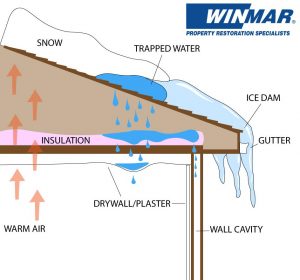What is ice damming and how can it be prevented?
What is ice damming and how can it be prevented?
Many homeowners believe that ice dams are a fact of life in cold and snowy climates. But did you know that ice damming is preventable?
To help us understand what causes this phenomenon, first we need to be familiar with how an attic functions. The attic is the space between the ceiling inside your home and the roof, with most homes today being constructed with roof trusses which form the attic. Insulation is installed along the floor of the attic on top of a vapor barrier so we only have to heat the living space below, and not the unoccupied attic space.
Through a combination of small imperfections or installation error, most vapor barriers are not 100% continuous and air tight. Varying amounts of warm moist air from inside your home will gradually rise through the drywall, past the vapor barrier, through the insulation, and into the air space inside your attic.
To prevent damage to the structure due to moisture buildup, homes are constructed with vents which allow outside air to pass through the attic space and flush the moisture out.
Ice damming begins to form when the warm air becomes trapped in the attic eventually heating the underside of the roof deck, which causes snow to melt on top of your roof. This melted snow freezes and forms a “dam” out of ice which starts to retain a small pool of water behind it.
Although roofs are very effective at shedding water downhill, due to their construction of overlapping materials they are not watertight when retaining a reservoir of water. As the pool of water sits over an extended period of time, it will gradually seep between your roof materials, into your attic, and eventually into the ceiling below.
Mold will begin flourish in a warm and dark attic space when water becomes available, putting the health of your family at risk. Unfortunately, by the time you notice your ceiling is showing signs of water staining, significant water damage has already occurred inside your attic space for an extended period of time which can be costly to repair.
Now that we have a better understanding of how an attic functions, what an ice dam is and the damage it can cause, the next question is how can we prevent ice damming from occurring? Fortunately, as with most building deficiencies the best place to start is by performing routine inspections. If an ice dam is visible on your roof it will help pinpoint the cause of the problem, however we recommend homeowners perform and attic inspection and look for the following even if they do not have ice damming:
- Do you notice a damp, musty smell when first entering the attic? This is an indicator that water damage has been occurring for an extended period of time, and mold growth is underway.
- Do you notice any discoloration or colorful spots on the wood members? Remember, where there is mold there is water.
- Does the insulation appear wet in any locations? Feel with your hand if you suspect it is. Because insulation permanently loses its R-value once it has been wet, we recommend replacing any wet areas with new insulation.
- Visually scan the floor of the attic, do you notice any gaps or depressions in the insulation? If so, you can fill in any small gaps by redistributing your insulation, or adding more insulation for larger gaps.
- Check your attic vents (gable, ridge, eave, etc) and ensure screens are in place and not blocked by leaves, debris, or animal nests.
- Pause for a moment, and feel for a slight draft or breeze through the attic. The temperature should feel similar to outdoors. If not, you may need to install additional vents in your attic.
- If you have visible ice damming, inspect the underside of the roof deck directly below the ice dam. Do you notice signs of moisture? Is the roof deck wet or frosty? Is the insulation below wet or showing a depression from water dripping on it?
Reminder – We advise homeowners to only inspect their attic if they know it is free from asbestos. Unqualified individuals should never inspect an attic that contains asbestos. If you are not sure, talk to a qualified expert for further guidance.
Conclusion:
As innocent as ice damming may appear from the ground, it can cause significant damage to your home in the thousands of dollars if it is allowed to form year after year. Mold remediation accounts for the single largest cost in long-term ice damming claims, however some home insurance policies do not cover mold remediation which leaves the homeowner paying for remediation out of pocket.
The good news is ice damming is preventable through routine visual inspections, and we hope the information above serves as a useful reminder of what to look for.

